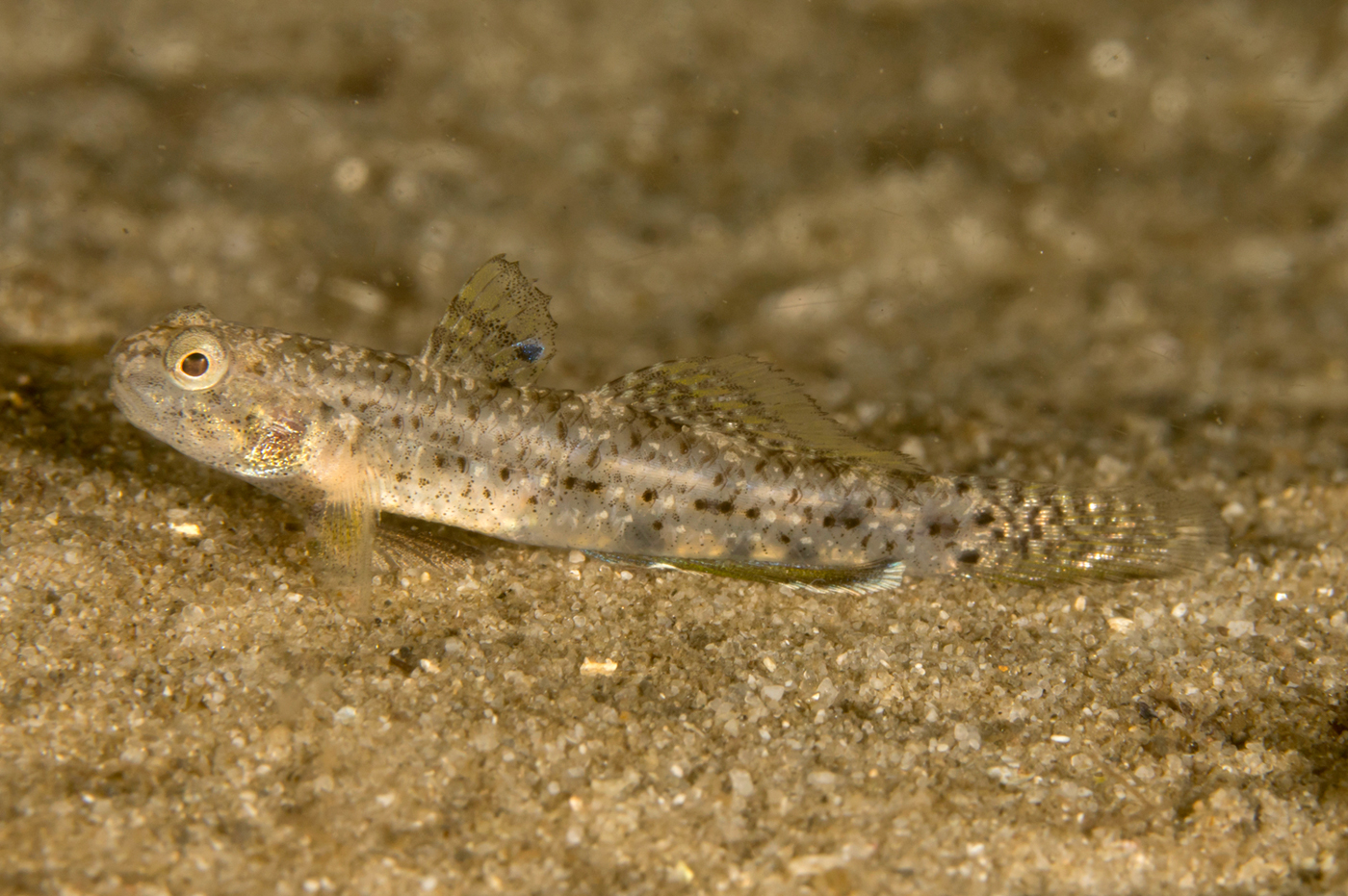Eastern Bluespot Goby, Pseudogobius eos Larson & Hammer 2021
Other Names: Bluespot Goby, Blue-spot Goby, Bluespotted Goby

A male Eastern Blue-spot Goby, Pseudogobius eos, in Currambene Creek, Jervis Bay, New South Wales, January 2019, depth 1.5m. Source: Andrew Green (@dentrock) / iNaturalist.org. License: CC by Attribution-NonCommercial
Summary:
A small estuarine goby with bulbous cheeks and a slightly overhanging snout. Males have a brown marbled pattern above and pale lower sides and belly, with bluish areas on the dorsal and anal fins, an orange spot on the front of the first dorsal fin, and brown vertical bands on the caudal fin. Females are less colourful.
This undescribed species of Pseudogobius has been long been confused with Pseudogobius olorum, which occurs in coastal areas of South Australia to the Murchison River, Western Australia.
This undescribed species of Pseudogobius has been long been confused with Pseudogobius olorum, which occurs in coastal areas of South Australia to the Murchison River, Western Australia.
Cite this page as:
Bray, D.J. 2022, Pseudogobius eos in Fishes of Australia, accessed 27 Jun 2025, https://fishesofaustralia.net.au/home/species/5229
Eastern Bluespot Goby, Pseudogobius eos Larson & Hammer 2021
More Info
|
Distribution |
Endemic to eastern Australia, from Agnes Water, southern Queensland, to central Victoria and Tasmania. Inhabits seagrass beds, sandy and muddy areas around aquatic vegetation in estuaries, coastal swamps and lagoons. The species may also may also enter the lower freshwater parts of streams. |
|
Colour |
Head and body translucent brownish grey, whitish ventrally; scales on most body with dark brown to red-brown cross-hatched or / shaped markings. About 6–8 dark brown short blotches across dorsum; about five rectangular to rounded dark brown spots along lateral midline and scattered smaller dark brown spots on dorsal half of body. Dark brown spot on scaled part of caudal fin just above last mid-lateral brown spot and similar dark spot at lower base of fin. Several small dark brown blotches or spots present just above pectoral fin base. Peritoneum silvery white over abdomen, usually showing through body wall. Side of head with short dark brown bar from lower rear edge of eye across cheek, may be second short oblique dark mark from above upper jaw. Iris dull golden to orange-gold. First dorsal fin transparent with 2–3 brown bands, broadest always along margin, remaining bands may be broken-up or missing; distinct black rounded blotch at rear of fin with bright blue area dorsally and behind black spot. Second dorsal fin transparent with 2–4 irregular rows of brownish spots and streaks. Anal fin transparent with brownish speckled on rays. Caudal fin transparent with about 5–6 irregular brownish bands, darkest near base. Pectoral fin transparent, with rounded dark brown spot at base of uppermost few rays. Pelvic fins with translucent pale golden rays. |
|
Remarks |
The distribution of this species overlaps with that of Pseudogobius olorum, and the central area of overlap in the two taxa (Murray Mouth to Glenelg River inclusive and north-west Tasmania) represents a hybrid zone between the taxa. |
|
Similar Species |
Differs from Pseudogobius olorum in having a second dorsal and anal fin ray count of I,6-8, usually I,7 (versus I,8-9, usually I,8 second dorsal rays and I,7–9, usually I,8 anal rays in P. olorum), fewer predorsal scales (7–10, usually 8, versus 8–11, usually 10), lower TRB count (usually 8 versus usually 10) and in a lower lateral scale count of 25–27 (versus 27–30). Although the two species are almost identical in colour pattern, P. olorum is typically appears more robust with a larger head in males (mean 25.5 in P. eos versus 27.8% SL in P. olorum ). |
|
Etymology |
The specific name is from the Greek eos (= dawn, east) in reference to the eastern Australian distribution of this species. |
|
Species Citation |
Pseudogobius eos Larson & Hammer 2021, Zootaxa 4961(1): 25, Figs. 9-10. Type locality: Port Hacking, Audley National Park, New South Wales, Australia |
|
Author |
Bray, D.J. 2022 |
|
Resources |
Eastern Bluespot Goby, Pseudogobius eos Larson & Hammer 2021
References
Allen, G.R., Midgley, S.H. & Allen, M. 2002. Field Guide to the Freshwater Fishes of Australia. Perth : Western Australian Museum 394 pp. (as Pseudogobius sp., in part; photo is Chlamydogobius ranunculus)
Ford, J.M.J., Tibbetts, I.R. & Carseldine, L. 2004. Ventilation rate and behavioural responses of two species of intertidal goby (Pisces: Gobiidae) at extremes of environmental temperature. Hydrobiologia 528: 63-73 https://doi.org/10.1007/s10750-004-2408-7 (as Pseudogobius sp. 4, in part)
Gee, J.H. & Gee, P.A. 1991. Reactions of gobioid fishes to hypoxia: buoyancy control and aquatic surface respiration, Copeia 1991(1): 17-28. https://doi.org/10.2307/1446244 (as Pseudogobius olorum)
Gee, J.H. & Gee, P.A. 1995. Aquatic surface respiration, buoyancy control and the evolution of air-breathing in gobies (Gobiidae: Pisces). Journal of Experimental Biology 198: 79-89. (as Pseudogobius olorum)
Hammer, M.P., Adams, M., Unmack, P.J., Hassell, K.L. & Bertozzi, T. 2021. Surprising Pseudogobius: Molecular systematics of benthic gobies reveals new insights into estuarine biodiversity (Teleostei: Gobiiformes). Molecular Phylogenetics and Evolution 60: 107140, https://doi.org/10.1016/j.ympev.2021.107140 ( as Pseudogobius sp. 9)
Hoese, D.F. & Larson, H.K. 2008. Family Gobiidae. pp. 749-773 in Gomon, M.F., Bray, D.J. & Kuiter, R.H. (eds) Fishes of Australia's Southern Coast. Sydney : Reed New Holland 928 pp. (as Pseudogobius sp. in part)
Larson, H.K. & Hammer, M.P. 2021. A revision of the gobiid fish genus Pseudogobius (Teleostei, Gobiidae, Tridentigerinae), with description of seven new species from Australia and South-east Asia. Zootaxa 4961(1), https://doi.org/10.11646/zootaxa.4961.1.1




